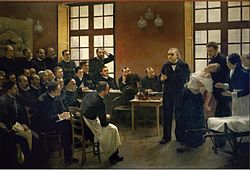Tourette syndrome
Tourette syndrome is an inherited neurological disorder. Tourette syndrome can also be called Tourette's syndrome, Tourette's disorder, GTS, Tourette's, or TS. People that have Tourette's have tics (movements or sounds that the person cannot easily control). Tourette's is normally inherited, and starts in childhood.
People who have Tourette's have a normal life expectancy and normal intelligence. Tics are normally not as bad as people get older. Adults with severe Tourette's are rare. Fewer than 15% of people with Tourette's have coprolalia. Coprolalia is using words or phrases that some people might find offensive without being able to stop saying them. These may include curse words. The typical Tourette's sufferer has coprolalia.
Most people with Tourette's do not need treatment. There are drugs that can help people manage tics. There are also therapies that can help people live easier with Tourette's.
The disease is named after Georges Gilles de la Tourette. He was one of the first doctors to describe the symptoms.
Also, people who have this syndrome might feel very depressed and have high chance to get depression.
Tourette Syndrome Media
Children displaying Tourette's tics
André Malraux (center) was a French Minister of Culture, author and adventurer who may have had Tourette syndrome.
The basal ganglia and thalamus are implicated in Tourette syndrome.
Tim Howard, described in 2019 by a staff writer for the Los Angeles Times as the "greatest goalkeeper in U.S. soccer history", attributes his success in the sport to his Tourette's.
Jean-Martin Charcot was a French neurologist and professor who named Tourette syndrome for his intern, Georges Gilles de la Tourette. In A Clinical Lesson at the Salpêtrière (1887), André Brouillet portrays a medical lecture by Charcot (the central standing figure) and shows de la Tourette in the audience (seated in the first row, wearing an apron).
Samuel Johnson c. 1772. Johnson is likely to have had Tourette syndrome.
Other websites
+{{{1}}}−{{{2}}}
- ↑ Sukhodolsky et al. (2017), p. 251.






